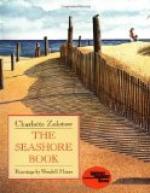We noticed these same poison darts when we were dealing with the flower-like animals, the Anemones. Only, in that case, they were so fine, so small, that they had no power to harm us, even though they entered our skin. You may remember that we called the Anemone a cousin of the Jelly-fish, for they both belong to the same lowly division of the Animal Kingdom.
Animals have queer ways of getting a living. Who would expect to find millions of poisoned darts in a Jelly-fish? Who would guess that these weapons are coiled up, ready to spring out at their prey? Men have made many weapons for killing, from the bow-and-arrow to the torpedo, but none of them is more wonderful than the weapon of the Jelly-fish.
EXERCISES
1. Where is the mouth of the Jelly-fish placed?
2. How does the Jelly-fish move through the water?
3. What is the food of the Jelly-fish?
4. How does it obtain its food?
[Illustration: SHELLS.
1. A FRESHWATER TURRET SHELL.
2. EDIBLE MUSSEL.
3. CONE SHELL.
4. SWORD-BLADE RAZOR-SHELL.
5. EAR SHELL, OR ORMER.
6. A TOP SHELL.
7. SCALLOP.
8. SWAN MUSSEL.]
LESSON X.
SHELLS AND THEIR BUILDERS (1).
THE PERIWINKLE, WHELK AND LIMPET.
Most of the shells which you find scattered over the shore are empty. The little animals which built them are gone; and their empty houses, of wonderful shapes and colours, are all that you find. Let us look at the builders of these pretty homes.
The shell-builders have soft, juicy bodies, and they are put in one big division of the animal kingdom—the mollusca, which only means soft-bodied. Some of these molluscs do not build shells. But most of them build a shelly house for themselves; they do this to defend their soft bodies from the attacks of a host of enemies. Some build two shells—the Oyster and Mussel do, as you know. These are called bi-valves; that is, two valves or shells; and others, like the Garden Snail, the Limpet, and Periwinkle, have one shell only, and so are called uni-valves.
The crab, and other crustaceans, also have a hard covering to their soft bodies; but it is not at all like the shell of a Snail, or other mollusc. The Snail’s shell is like the little boy’s suit which is altered and made bigger as the boy grows. The crab’s covering is a suit which cannot be altered. It must be thrown away, and replaced by a larger one.
The body of the shell-builder is wrapped in a soft covering, a kind of outer coat, which is called the mantle. Now this mantle is one of Nature’s cleverest inventions. It is able to take the substance called lime from the food of the animal, and to use it as building stuff.




